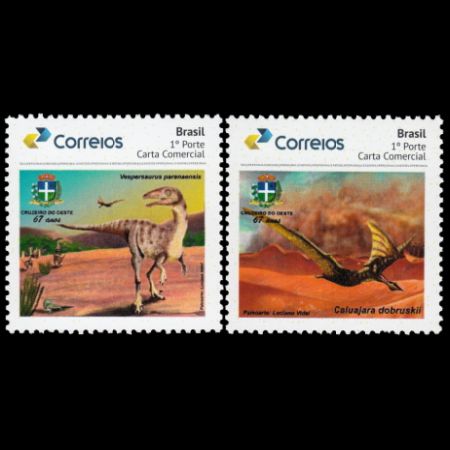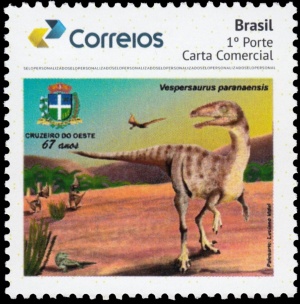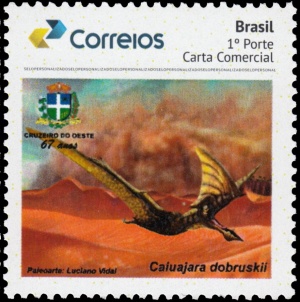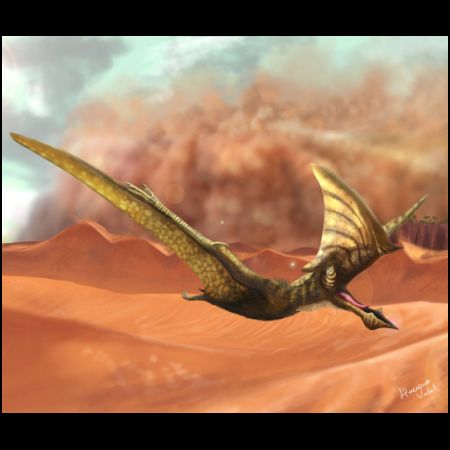Brazil 2019 "Prehistoric animals of Parana region"
| <prev | back to index | next> |
| Issue Date | 12.12.2019 |
| ID | Michel: N/A, Scott: N/A, Stanley Gibbons: N/A, Yvert et Tellier: N/A, Category: pR |
| Design | Luciano Vidal |
| Stamps in set | 2 |
| Value |
1o Porte Carta Comercial (1,95r) - Vespersaurus paranaensis 1o Porte Carta Comercial (1,95r) -Caiuajara debruskii |
| Size (width x height) | stamps: 35 mm x 35 mm, Mini-Sheets: |
| Layout | Two mini sheets of 12 stamps each |
| Products | None |
| Paper | |
| Perforation | 11,25 x 11,25 |
| Print Technique | |
| Printed by | |
| Quantity | |
| Issuing Authority | Correios Brazil |

On December 12, 2019, Brazilian Post issued a set of two personalized stamps "Prehistoric animals of Parana region", printed in two Mini-Sheets of 12 stamps each with an increased images on the top. Both stamps were designed by young Brazilian paleoartist Luciano Vidal. One of the stamps shows a dinosaur Vespersaurus paranaensis, another one shows a pterosaur Caiuajara debruskii whose fossils were found in the the Parana state of Brazil.
The following text is translation of the press release published by Brazilian Post in 2019.
 |
| Vespersaurus paranaensis on personalized stamp of Brazil 2019 |
 |
| Caiuajara debruskiion on personalized stamp of Brazil 2019 |
A small, carnivorous dinosaur with short arms and a biped - whose body weight is supported on the central toe. This is Vespersaurus paranaensis , an unprecedented specimen in the world, found in the Cruzeiro do Oeste region, a municipality of 21 thousand inhabitants in the Northwest of Parana. The discovery of the fossil was announced at a news conference in June 2019, as a result of research done by the State University of Maringa (UEM), University of Sao Paulo (USP) and the Paleontological Museum of Cruzeiro do Oeste. The study on the first dinosaur “100% Paraná” was published in the scientific journal Scientific Reports.
The name came from the junction of vesper (west, in Latin; homage to the city in which it was found) and saurus (lizard, also in Latin).
Vespersaurus paranaensis, who lived 90 million years ago, in the Cretaceous period, was found in the same paleontological site where numerous individuals of the pterosaur Caiuajara debruskii had already been discovered.
Among the main anatomical characteristics that made them deserve a new classification, differentiating them from the known species of pterosaur, is the fact that they have the “beak”, that is, the final part of the mandible, more inclined downwards than the others.
In addition, the animals have concavities in the roof of the mouth and in the lower arch, the latter being more pronounced, and whose usefulness the researchers have not yet discovered. Researchers estimate that the animal lived in the Upper Cretaceous period, some 80 million years ago.
The importance of this discovery, in addition to being a new species, lies in the accumulation of fossils at the site. This is the first accumulation of pterosaurs found in the country, and the third worldwide. The first occurred in Argentina, in the 1990s, and the second in China, in 2014. Among the three, Parana accumulation is the one with the highest number of individuals identified so far.
A possible explanation for this concentration is the fact that the Cruzeiro do Oeste region was a desert at the time when these animals inhabited the place. For this reason, pterosaurs probably concentrated around some type of oasis, which would explain the conditions in which the bones were found (dismantled and mixed).
Products and associated philatelic items
| Mini-Sheets | Examples of circulated cover | One of the Artworks |
 |
 |
 |
| The image was provided by the paleoartist Mr. Luciano Vidal |

|
References
- Technical details and stamps presentation:
Post of Brazil - Stamps designer - Luciano Vidal:
official blog
| <prev | back to index | next> |